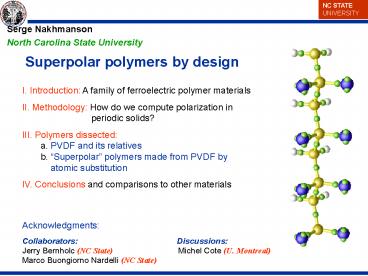I. Introduction: A family of ferroelectric polymer materials - PowerPoint PPT Presentation
1 / 22
Title:
I. Introduction: A family of ferroelectric polymer materials
Description:
Jerry Bernholc (NC State) Michel Cote (U. Montreal) Marco Buongiorno ... odd nylons, polyurea, etc. PVDF copolymers. with trifluoroethylene. P(VDF/TrFE) ... – PowerPoint PPT presentation
Number of Views:392
Avg rating:3.0/5.0
Title: I. Introduction: A family of ferroelectric polymer materials
1
Serge Nakhmanson North Carolina State University
Superpolar polymers by design
I. Introduction A family of ferroelectric
polymer materials II. Methodology How do we
compute polarization in
periodic solids? III. Polymers dissected a.
PVDF and its relatives b. Superpolar polymers
made from PVDF by atomic substitution IV.
Conclusions and comparisons to other materials
Acknowledgments Collaborators
Discussions Jerry
Bernholc (NC State)
Michel Cote (U. Montreal) Marco Buongiorno
Nardelli (NC State)
2
Introduction
3
Boron-Nitride nanotubes quasi-1D
nano-piezoelectrics
Carbon
Boron-Nitride
Zigzag nanotube index
All wide zigzag or chiral BN nanotubes are not
pyroelectric due to screw symmetry! But breaking
of the screw symmetry by bundling or deforming
BNNTs makes them weakly pyroelectric
See Nakhmanson et al. PRB 2003
4
The nature of polarization in PVDF and its
relatives
Representatives polyvinylidene fluoride (PVDF),
PVDF copolymers, odd
nylons, polyurea, etc.
PVDF copolymers
5
Growth and manufacturing
Pictures from A. J. Lovinger, Science 1983
6
Growth and manufacturing
ß-PVDF
Pictures from A. J. Lovinger, Science 1983
7
Growth and manufacturing
PVDF grown approx. 50 crystalline
Copolymers can be grown 80-90 crystalline!
ß-PVDF
8
Dipole summation models for polarization in PVDF
Which model is better? What about copolymers? Ab
Initio calculations can answer these questions
9
Computing polarization
10
Computing polarization in a periodic solid
Modern theory of polarization R. D.
King-Smith D. Vanderbilt, PRB 1993 R.
Resta, RMP 1994
1) Polarization is a multivalued quantity and its
absolute value cannot be computed.
2) Polarization derivatives are well defined and
can be computed.
The scheme to compute polarization with MTP can
be easily formulated in the language of the
density functional theory.
11
Some technical details
- Massively parallel real-space multigrid method
to solve - Kohn-Sham equations
- See E. L. Briggs, D. J. Sullivan and J.
Bernholc, PRB 1996 - Density functional theory with generalized
gradient approximation - for the exchange-correlation interaction
- Non-local, norm-conserving pseudopotentials in
separable form - Berry-phase method for polarization calculations
- Accurate Brillouin zone sampling
- High energy cutoffs (70-100 Ry)
12
Polarization in ferroelectric polymers
13
Polarization in ß-PVDF from the first principles
ß-PVDF polar
No sensible comparison to experiment because
ß-PVDF is only 50 crystalline!
14
Polarization in PVDF copolymers
Copolymers can be grown 80-90 crystalline!
15
Piezoelectricity in PVDF and copolymers
PVDF PVDF/TrFE 75/25 PVDF/TeFE 75/25
-0.268 (-0.130) 1 (-0.26) 2 -0.183 -0.135
-0.270 (-0.145) 1 (-0.09) 2 -0.192 -0.145
-0.332 (-0.276) 1 (-0.25) 2 -0.211 -0.150
1 Tashiro et al. Macromolecules, 1980 2
Carbeck and Rutledge, Polymer, 1996
16
- PVDF and copolymers
- good agreement between our calculations
- and the experiments
- this proves the validity of our approach for
- polymeric substances
17
Backbone substitution in PVDF
PVDF
18
Backbone substitution in PVDF
PVDF
Question How large will be the improvement in
polarization?
An ab initio calculation will give us a good
estimate!
19
Polarization in BN-based polymers
ß-PVDF 0.178 -0.268 -0.270 -0.332
PADFB 0.362 -0.493 -0.580 -0.555
PAB 0.300 -0.348 -0.398 -0.431
PbTiO3 0.88 -0.93 3.23
PbTiO3 data from G. Saghi-Szabo et. al. PRL
1998, PRB 1999.
PADFB polar properties improve by approximately
100
20
Polar materials the big picture
21
Conclusions
- Quantum mechanical theory of
- polarization works well in polymer
- materials like ß-PVDF and its
- copolymers.
- Our results for ß-PVDF can be
- used to calibrate empirical models
- for polarization in this polymer
- Intuitive models can be combined with first
principles calculations of polarization to
design superpolar polymers - Excellent mechanical and environmental properties
inherited from PVDF - Polar properties up to 100 better than in PVDF
- Enhanced thermal stability
- Numerous applications sensors, actuators,
transducers - Have been already synthesized, but only as
precursors for other materials - A whole zoo of other polar polymers to play with
- Preprint available
22
Future projects
Empirical model of polarization in PVDF
and copolymers from the Wannier function centers?































